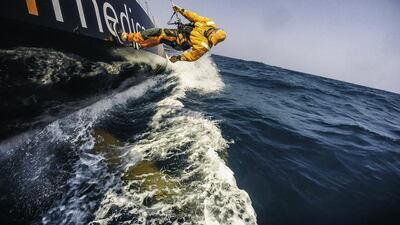When Team Vestas Wind crashed into a shallow reef off Mauritius last November, a bunch of guys in New Zealand were the first people after the crew to know something had just gone terribly wrong.
When a phone call came in, Ian Taylor and his team of technicians at Virtual Eye (VE) in New Zealand already knew something was up.
“We saw it because we’re tracking them,” said Taylor, the head of VE. “Our guy in Alicante was getting tracking data to make videos.
“He saw the boat stop. It could’ve been anything – the data stopped coming in, or anything. But then he saw there were shoals around there and all the other data was working so maybe something had happened.
“In the old days, when nobody was tracking, no one could visualise it, how long would it have taken to know that had happened?”
VE is the sports arm of Animation Research Limited (ARL) and it would not be hyperbole to say it has revolutionised sailing.
The virtual tracker it has created is one of the standout features of the Volvo Ocean Race (VOR) app, which has swiftly become one of the standout features of the race this year.
The tracker is the only way of keeping abreast of a sporting event that takes place beyond the view of any spectators.
The VOR is probably the only sport that can neither be broadcast, nor followed by fans in person. It is one of the structural problems of sailing as spectator sport. An official who works on the tracking, had previously been in TV, where he filmed sailing. “You had no idea and trying to tell a race story in a package afterwards was an absolute nightmare because nobody knew what had happened. It was all just pretty pictures.”
All the boats now have trackers from which VE picks up signals every 10 seconds.
From that data it maps out the position of each boat and can, whenever it needs, turn it into the animation you see either on the VOR website or on the tracker.
During the in-port races and leg arrivals and departures, it picks up data in real-time so the animation of those segments on the site is, effectively, live.
Though they are monitoring movements through the 10-second signals at Race HQ in Alicante, once the boats are out on a leg the app tracker updates positions every three hours.
The boats receive positional updates from the tracker every six hours, thereby leading to a unique sporting situation where fans are better aware of the entire standings of the race than the competitors.
Race rules prevent boats getting live updates – though they can be provided – so that the nature of the racing is not affected. “Basically they have to chart their own course because otherwise it wouldn’t be much of a race,” one official said.
“You probably would just end up doing a lot more follow-the-leader stuff, which would make it less interesting and take out the navigational aspects of it.”
As a way to get into the race, the tracker is compelling. Although the methods are modern, following it is an old-fashioned process. It is similar to listening to radio broadcasts of the cricket, in that, with some information and a lot of imagination, it becomes a fascinating experience.
All details the casual follower could want are there: speeds, wind conditions, distances between the boats, or to the finish.
Any part of the leg, or the entire leg, can be replayed. The clincher is a 3D viewing option, with considerably detailed animations of each boat.
Hard-core sailing fans have, apparently, griped about how dumbed-down the tracker is and have wanted more technical data, such as on the weather.
But for a sport trying to expand its following beyond that core, it is perfect – about 280,000 app downloads suggests so.
The revolution began in the early 1990s, when Taylor got involved with the broadcasters of the America’s Cup.
“We thought there’s got to be something we can do with this because you can’t even tell who’s close,” he said.
“So we developed this animation for TV, the first of its kind, in real-time we tracked these boats with the data that was coming off them and brought a whole new level to the coverage.”
The internet changed everything. Having started with graphics on TV, VE moved to providing data on CD-ROM, loaded on to personal computers. In 2000 the America’s Cup in Auckland came to people on the internet for the first time.
The transformation in graphics from 1993-2009 is neatly captured in a video on VE’s site, from a bare bones image of a boat moving in its earliest days to the kind of detailed graphic now available, with similar detail in the graphics of the environment around the boat.
Last year the revolution was crowned. The America’s Cup app, developed wholly by VE, won an Emmy for Outstanding New Approaches – Sports Event Coverage.
osamiuddin@thenational.ae
Follow our sports coverage on Twitter @SprtNationalUAE

